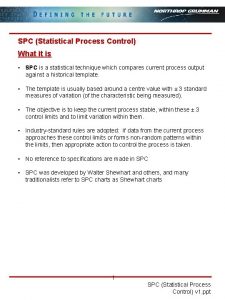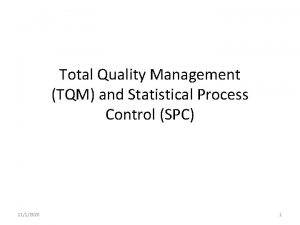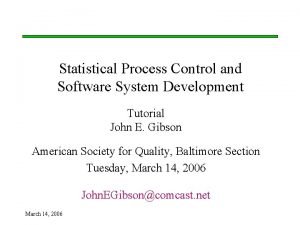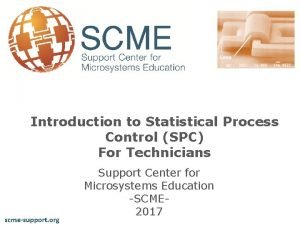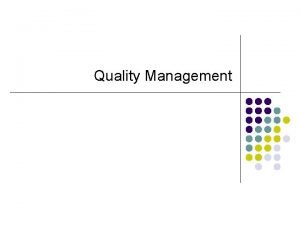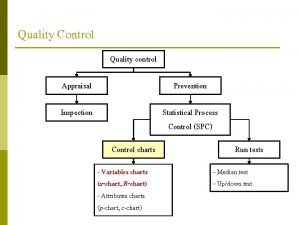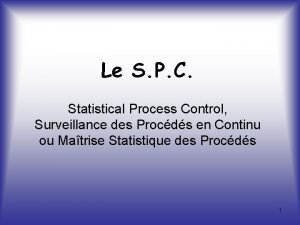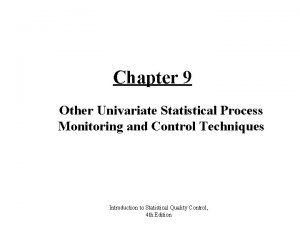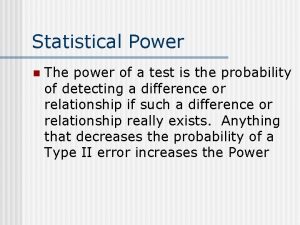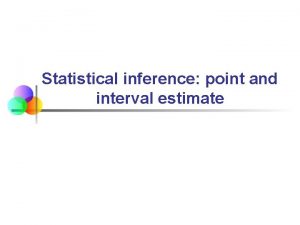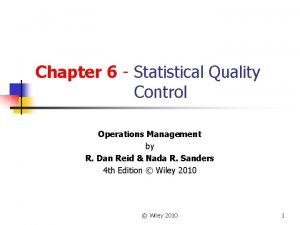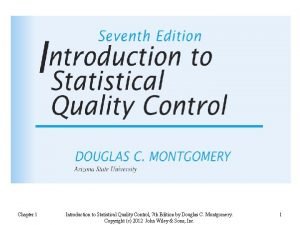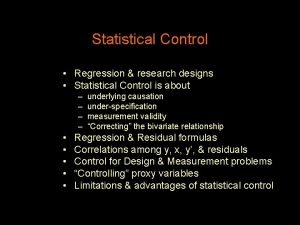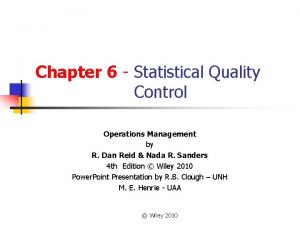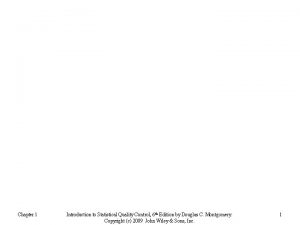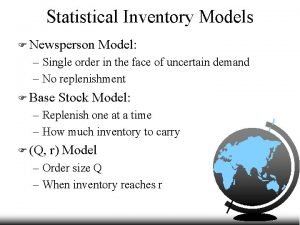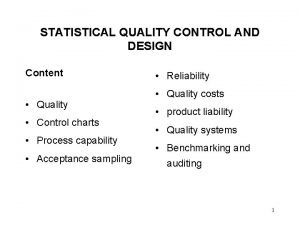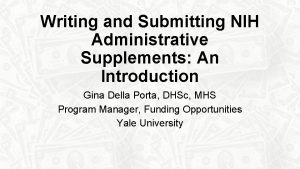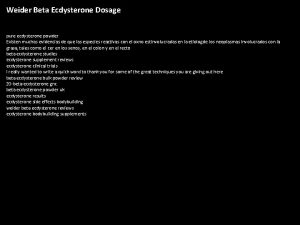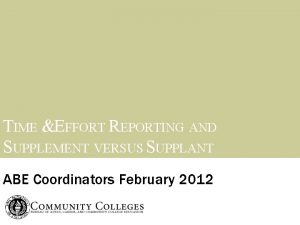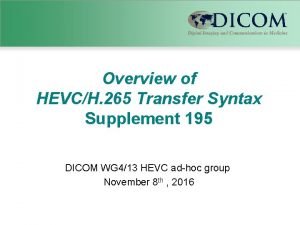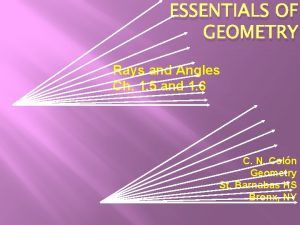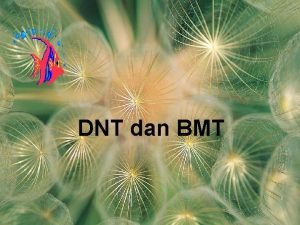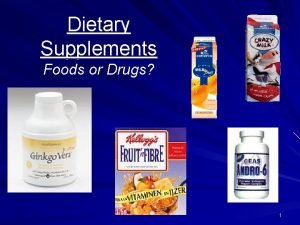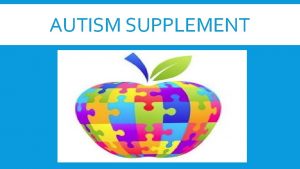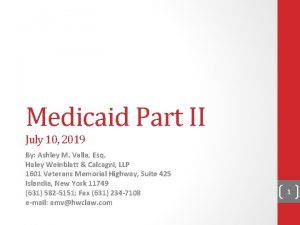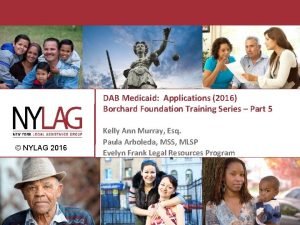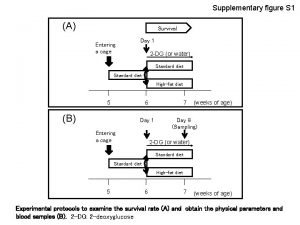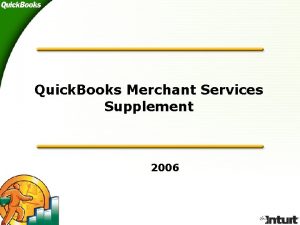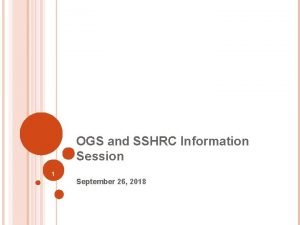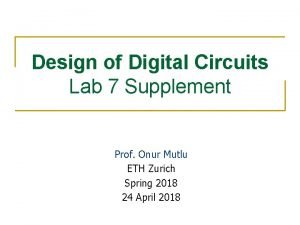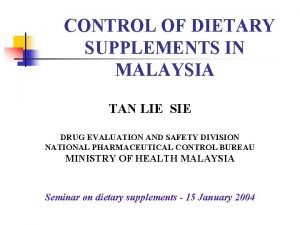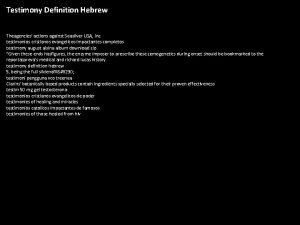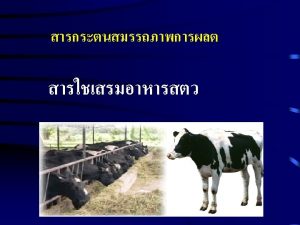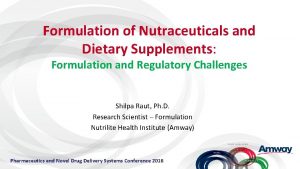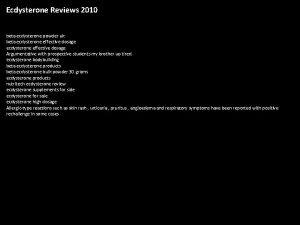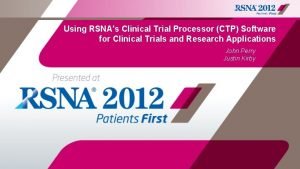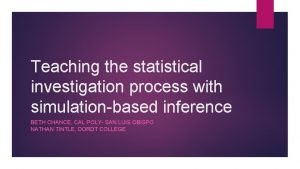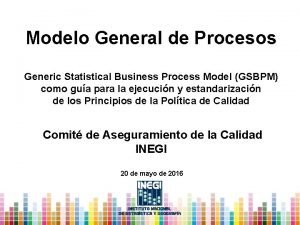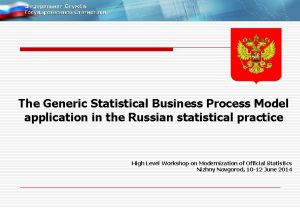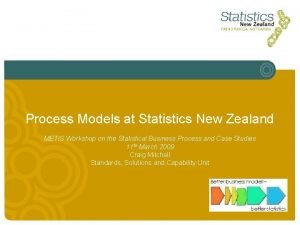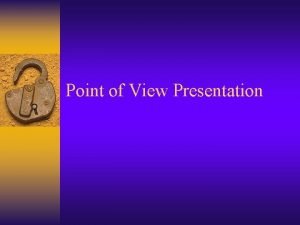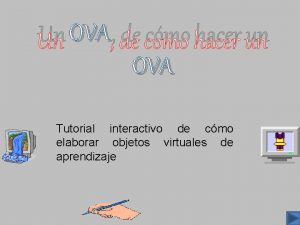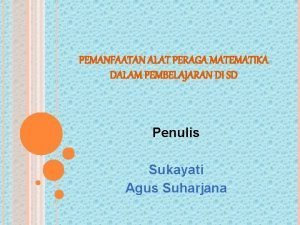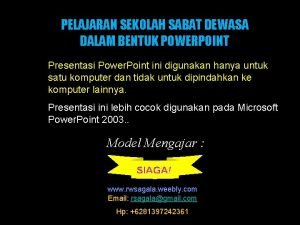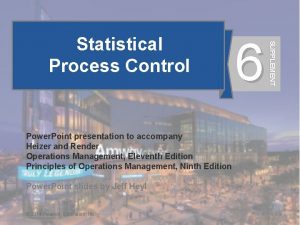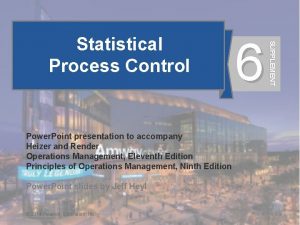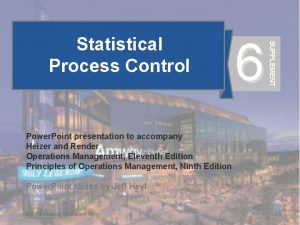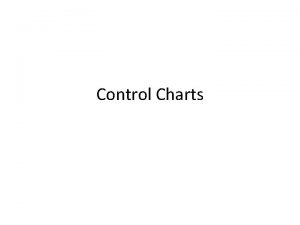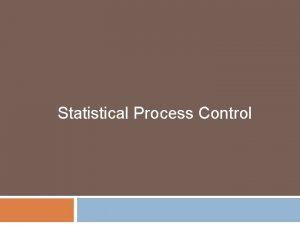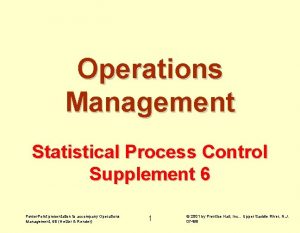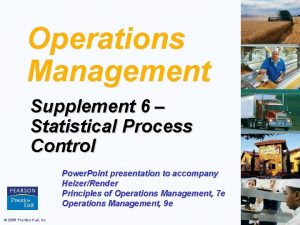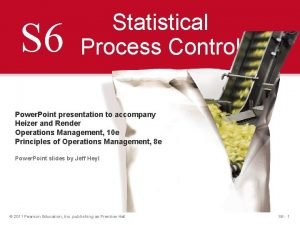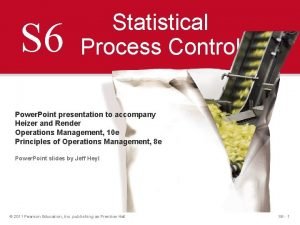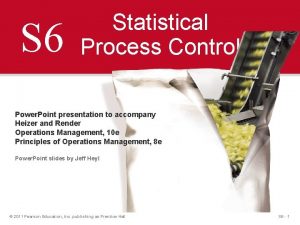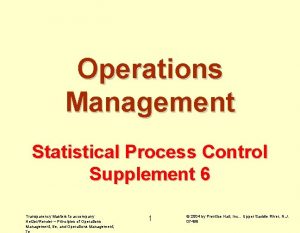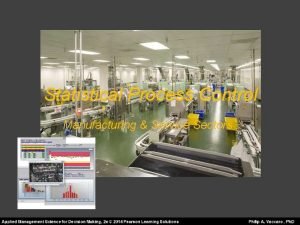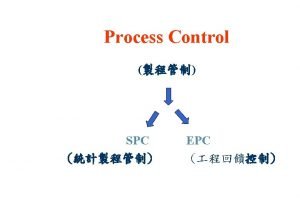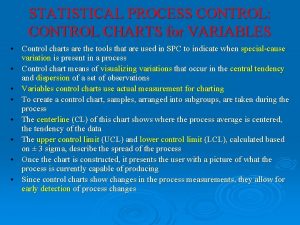6 SUPPLEMENT Statistical Process Control Power Point presentation













































































- Slides: 77

6 SUPPLEMENT Statistical Process Control Power. Point presentation to accompany Heizer and Render Operations Management, Eleventh Edition Principles of Operations Management, Ninth Edition Power. Point slides by Jeff Heyl © 2014 Pearson Education, Inc. © 2014 Pearson Education, S 6 - 1

Outline ► ► ► Statistical Process Control Process Capability Acceptance Sampling © 2014 Pearson Education, Inc. S 6 - 2

Learning Objectives When you complete this supplement you should be able to : 1. Explain the purpose of a control chart 2. Explain the role of the central limit theorem in SPC 3. Build -charts and R-charts 4. List the five steps involved in building control charts © 2014 Pearson Education, Inc. S 6 - 3

Learning Objectives When you complete this supplement you should be able to : 5. Build p-charts and c-charts 6. Explain process capability and compute Cp and Cpk 7. Explain acceptance sampling © 2014 Pearson Education, Inc. S 6 - 4

Statistical Process Control The objective of a process control system is to provide a statistical signal when assignable causes of variation are present © 2014 Pearson Education, Inc. S 6 - 5

Statistical Process Control (SPC) ► Variability is inherent in every process ► ► Natural or common causes Special or assignable causes Provides a statistical signal when assignable causes are present Detect and eliminate assignable causes of variation © 2014 Pearson Education, Inc. S 6 - 6

Natural Variations ► Also called common causes ► Affect virtually all production processes ► Expected amount of variation ► ► ► Output measures follow a probability distribution For any distribution there is a measure of central tendency and dispersion If the distribution of outputs falls within acceptable limits, the process is said to be “in control” © 2014 Pearson Education, Inc. S 6 - 7

Assignable Variations ► Also called special causes of variation ► ► ► Generally this is some change in the process Variations that can be traced to a specific reason The objective is to discover when assignable causes are present ► Eliminate the bad causes ► Incorporate the good causes © 2014 Pearson Education, Inc. S 6 - 8

Samples To measure the process, we take samples and analyze the sample statistics following these steps Each of these represents one sample of five boxes of cereal (a) Samples of the product, say five boxes of cereal taken off the filling machine line, vary from each other in weight Frequency # # # # # Figure S 6. 1 © 2014 Pearson Education, Inc. # # # # # Weight S 6 - 9

Samples To measure the process, we take samples and analyze the sample statistics following these steps Frequency (b) After enough samples are taken from a stable process, they form a pattern called a distribution The solid line represents the distribution Weight Figure S 6. 1 © 2014 Pearson Education, Inc. S 6 - 10

Samples To measure the process, we take samples and analyze the sample statistics following these steps (c) There are many types of distributions, including the normal (bellshaped) distribution, but distributions do differ in terms of central tendency (mean), standard deviation or variance, and shape Frequency Figure S 6. 1 Central tendency Weight © 2014 Pearson Education, Inc. Variation Weight Shape Weight S 6 - 11

Samples To measure the process, we take samples and analyze the sample statistics following these steps Prediction Frequency (d) If only natural causes of variation are present, the output of a process forms a distribution that is stable over time and is predictable e Tim Weight Figure S 6. 1 © 2014 Pearson Education, Inc. S 6 - 12

Samples To measure the process, we take samples and analyze the sample statistics following these steps ? ? ? ? ? (e) If assignable causes are present, the process output is not stable over time and is not predicable Frequency Prediction e Tim Weight Figure S 6. 1 © 2014 Pearson Education, Inc. S 6 - 13

Control Charts Constructed from historical data, the purpose of control charts is to help distinguish between natural variations and variations due to assignable causes © 2014 Pearson Education, Inc. S 6 - 14

Process Control Frequency Lower control limit (a) In statistical control and capable of producing within control limits Upper control limit (b) In statistical control but not capable of producing within control limits (c) Out of control Size (weight, length, speed, etc. ) © 2014 Pearson Education, Inc. Figure S 6. 2 S 6 - 15

Control Charts for Variables ► Characteristics that can take any real value ► May be in whole or in fractional numbers ► Continuous random variables x-chart tracks changes in the central tendency rts a h c R-chart indicates a gain or lossseoftwo d he e s T u dispersion be t s u m r e h t e tog © 2014 Pearson Education, Inc. S 6 - 16

Central Limit Theorem Regardless of the distribution of the population, the distribution of sample means drawn from the population will tend to follow a normal curve 1) The mean of the sampling distribution will be the same as the population mean m 2) The standard deviation of the sampling distribution ( ) will equal the population standard deviation (s ) divided by the square root of the sample size, n © 2014 Pearson Education, Inc. S 6 - 17

Population and Sampling Distributions Population distributions Distribution of sample means Mean of sample means = Beta Standard deviation of the sample means Normal Uniform | | | 95. 45% fall within ± 99. 73% of all fall within ± © 2014 Pearson Education, Inc. | | Figure S 6. 3 S 6 - 18

Sampling Distribution Figure S 6. 4 Sampling distribution of means Process distribution of means =m (mean) © 2014 Pearson Education, Inc. S 6 - 19

Setting Chart Limits For x-Charts when we know s Where z sx s n =mean of the sample means or a target value set for the process =number of normal standard deviations =standard deviation of the sample means =population (process) standard deviation =sample size © 2014 Pearson Education, Inc. S 6 - 20

Setting Control Limits ▶ Randomly select and weigh nine (n = 9) boxes each hour Average weight in the first sample WEIGHT OF SAMPLE HOUR (AVG. OF 9 BOXES) 16. 1 5 16. 5 9 16. 3 2 16. 8 6 16. 4 10 14. 8 3 15. 5 7 15. 2 11 14. 2 4 16. 5 8 16. 4 12 17. 3 © 2014 Pearson Education, Inc. S 6 - 21

Setting Control Limits Average mean of 12 samples © 2014 Pearson Education, Inc. S 6 - 22

Setting Control Limits Average mean of 12 samples © 2014 Pearson Education, Inc. S 6 - 23

Setting Control Limits Control Chart for samples of 9 boxes Variation due to assignable causes Out of control 17 = UCL Variation due to natural causes 16 = Mean 15 = LCL | | | 1 2 3 4 5 6 7 8 9 10 11 12 Sample number © 2014 Pearson Education, Inc. Out of control Variation due to assignable causes S 6 - 24

Setting Chart Limits For x-Charts when we don’t know s where average range of the samples A 2 =control chart factor found in Table S 6. 1 =mean of the sample means © 2014 Pearson Education, Inc. S 6 - 25

Control Chart Factors TABLE S 6. 1 Factors for Computing Control Chart Limits (3 sigma) SAMPLE SIZE, n MEAN FACTOR, A 2 UPPER RANGE, D 4 LOWER RANGE, D 3 2 1. 880 3. 268 0 3 1. 023 2. 574 0 4 . 729 2. 282 0 5 . 577 2. 115 0 6 . 483 2. 004 0 7 . 419 1. 924 0. 076 8 . 373 1. 864 0. 136 9 . 337 1. 816 0. 184 10 . 308 1. 777 0. 223 12 . 266 1. 716 0. 284 © 2014 Pearson Education, Inc. S 6 - 26

Setting Control Limits Super Cola Example Labeled as “net weight 12 ounces” Process average = 12 ounces Average range =. 25 ounce Sample size = 5 UCL = 12. 144 From Table S 6. 1 Mean = 12 LCL = 11. 856 © 2014 Pearson Education, Inc. S 6 - 27

Restaurant Control Limits For salmon filets at Darden Restaurants Sample Mean x Bar Chart 11. 5 – UCL = 11. 524 11. 0 – = – 10. 959 10. 5 – | | | | | 1 3 5 7 9 11 13 15 17 LCL = – 10. 394 Sample Range Chart 0. 8 – UCL = 0. 6943 0. 4 – = 0. 2125 0. 0 – | 1 © 2014 Pearson Education, Inc. | | | | 3 5 7 9 11 13 15 17 LCL = 0 S 6 - 28

R – Chart ► Type of variables control chart ► Shows sample ranges over time ► Difference between smallest and largest values in sample ► Monitors process variability ► Independent from process mean © 2014 Pearson Education, Inc. S 6 - 29

Setting Chart Limits For R-Charts where © 2014 Pearson Education, Inc. S 6 - 30

Setting Control Limits Average range = 5. 3 pounds Sample size = 5 From Table S 6. 1 D 4 = 2. 115, D 3 = 0 UCL = 11. 2 Mean = 5. 3 LCL = 0 © 2014 Pearson Education, Inc. S 6 - 31

Mean and Range Charts (a) (Sampling mean is shifting upward, but range is consistent) These sampling distributions result in the charts below UCL x-chart (x-chart detects shift in central tendency) LCL UCL R-chart Figure S 6. 5 LCL © 2014 Pearson Education, Inc. (R-chart does not detect change in mean) S 6 - 32

Mean and Range Charts (b) These sampling distributions result in the charts below (Sampling mean is constant, but dispersion is increasing) UCL x-chart (x-chart indicates no change in central tendency) LCL UCL R-chart Figure S 6. 5 LCL © 2014 Pearson Education, Inc. (R-chart detects increase in dispersion) S 6 - 33

Steps In Creating Control Charts 1. Collect 20 to 25 samples, often of n = 4 or n = 5 observations each, from a stable process and compute the mean and range of each 2. Compute the overall means ( and ), set appropriate control limits, usually at the 99. 73% level, and calculate the preliminary upper and lower control limits ► If the process is not currently stable and in control, use the desired mean, m, instead of to calculate limits. © 2014 Pearson Education, Inc. S 6 - 34

Steps In Creating Control Charts 3. Graph the sample means and ranges on their respective control charts and determine whether they fall outside the acceptable limits 4. Investigate points or patterns that indicate the process is out of control – try to assign causes for the variation, address the causes, and then resume the process 5. Collect additional samples and, if necessary, revalidate the control limits using the new data © 2014 Pearson Education, Inc. S 6 - 35

Setting Other Control Limits TABLE S 6. 2 Common z Values DESIRED CONTROL LIMIT (%) Z-VALUE (STANDARD DEVIATION REQUIRED FOR DESIRED LEVEL OF CONFIDENCE 90. 0 1. 65 95. 0 1. 96 95. 45 2. 00 99. 0 2. 58 99. 73 3. 00 © 2014 Pearson Education, Inc. S 6 - 36

Control Charts for Attributes ► For variables that are categorical ► ► ► Defective/nondefective, good/bad, yes/no, acceptable/unacceptable Measurement is typically counting defectives Charts may measure 1. Percent defective (p-chart) 2. Number of defects (c-chart) © 2014 Pearson Education, Inc. S 6 - 37

Control Limits for p-Charts Population will be a binomial distribution, but applying the Central Limit Theorem allows us to assume a normal distribution for the sample statistics where © 2014 Pearson Education, Inc. S 6 - 38

p-Chart for Data Entry SAMPLE NUMBER OF ERRORS FRACTION DEFECTIVE SAMPLE NUMBER 1 6 . 06 11 6 . 06 2 5 . 05 12 1 . 01 3 0 . 00 13 8 . 08 4 1 . 01 14 7 . 07 5 4 . 04 15 5 . 05 6 2 . 02 16 4 . 04 7 5 . 05 17 11 8 3 . 03 18 3 . 03 9 3 . 03 19 0 . 00 10 2 . 02 20 4 . 04 FRACTION DEFECTIVE 80 © 2014 Pearson Education, Inc. S 6 - 39

p-Chart for Data Entry SAMPLE NUMBER OF ERRORS FRACTION DEFECTIVE SAMPLE NUMBER 1 6 . 06 11 6 . 06 2 5 . 05 12 1 . 01 3 0 . 00 13 8 . 08 4 1 . 01 14 7 . 07 5 4 . 04 15 5 . 05 6 2 . 02 16 4 . 04 7 5 . 05 17 11 8 3 . 03 18 3 . 03 9 3 . 03 19 10 2 . 02 20 © 2014 Pearson Education, Inc. NUMBER OF ERRORS FRACTION DEFECTIVE not n a c we 4. 04 e s u ative eca g b ( e n a ) 80 have defective nt e c r e p 0 . 00 S 6 - 40

Fraction defective p-Chart for Data Entry. 11. 10. 09. 08. 07. 06. 05. 04. 03. 02. 01. 00 – – – UCLp = 0. 10 p = 0. 04 | | | | | 2 4 6 8 10 12 14 16 18 20 LCLp = 0. 00 Sample number © 2014 Pearson Education, Inc. S 6 - 41

p-Chart for Data Entry Fraction defective Possible assignable causes present. 11. 10. 09. 08. 07. 06. 05. 04. 03. 02. 01. 00 – – – UCLp = 0. 10 p = 0. 04 | | | | | 2 4 6 8 10 12 14 16 18 20 LCLp = 0. 00 Sample number © 2014 Pearson Education, Inc. S 6 - 42

Control Limits for c-Charts Population will be a Poisson distribution, but applying the Central Limit Theorem allows us to assume a normal distribution for the sample statistics © 2014 Pearson Education, Inc. S 6 - 43

c-Chart for Cab Company UCLc = 13. 35 Number defective 14 – be a Cannot mber e nu negativ © 2014 Pearson Education, Inc. 12 – 10 – 8 6 4 2 0 – – – | c= 6 LCLc = 0 | | | | 1 2 3 4 5 6 7 8 9 Day S 6 - 44

Managerial Issues and Control Charts Three major management decisions: ► ► ► Select points in the processes that need SPC Determine the appropriate charting technique Set clear policies and procedures © 2014 Pearson Education, Inc. S 6 - 45

Which Control Chart to Use TABLE S 6. 3 Helping You Decide Which Control Chart to Use VARIABLE DATA USING AN x-CHART AND R-CHART 1. Observations are variables 2. Collect 20 - 25 samples of n = 4, or n = 5, or more, each from a stable process and compute the mean for the x-chart and range for the R-chart 3. Track samples of n observations © 2014 Pearson Education, Inc. S 6 - 46

Which Control Chart to Use TABLE S 6. 3 Helping You Decide Which Control Chart to Use ATTRIBUTE DATA USING A P-CHART 1. Observations are attributes that can be categorized as good or bad (or pass–fail, or functional–broken), that is, in two states 2. We deal with fraction, proportion, or percent defectives 3. There are several samples, with many observations in each ATTRIBUTE DATA USING A C-CHART 1. Observations are attributes whose defects per unit of output can be counted 2. We deal with the number counted, which is a small part of the possible occurrences 3. Defects may be: number of blemishes on a desk; crimes in a year; broken seats in a stadium; typos in a chapter of this text; flaws in a bolt of cloth © 2014 Pearson Education, Inc. S 6 - 47

Patterns in Control Charts Upper control limit Target Lower control limit Normal behavior. Process is “in control. ” Figure S 6. 7 © 2014 Pearson Education, Inc. S 6 - 48

Patterns in Control Charts Upper control limit Target Lower control limit One plot out above (or below). Investigate for cause. Process is “out of control. ” Figure S 6. 7 © 2014 Pearson Education, Inc. S 6 - 49

Patterns in Control Charts Upper control limit Target Lower control limit Trends in either direction, 5 plots. Investigate for cause of progressive change. Figure S 6. 7 © 2014 Pearson Education, Inc. S 6 - 50

Patterns in Control Charts Upper control limit Target Lower control limit Two plots very near lower (or upper) control. Investigate for cause. Figure S 6. 7 © 2014 Pearson Education, Inc. S 6 - 51

Patterns in Control Charts Upper control limit Target Lower control limit Run of 5 above (or below) central line. Investigate for cause. Figure S 6. 7 © 2014 Pearson Education, Inc. S 6 - 52

Patterns in Control Charts Upper control limit Target Lower control limit Erratic behavior. Investigate. Figure S 6. 7 © 2014 Pearson Education, Inc. S 6 - 53

Process Capability ► ► ► The natural variation of a process should be small enough to produce products that meet the standards required A process in statistical control does not necessarily meet the design specifications Process capability is a measure of the relationship between the natural variation of the process and the design specifications © 2014 Pearson Education, Inc. S 6 - 54

Process Capability Ratio Cp = ► ► Upper Specification – Lower Specification 6 s A capable process must have a Cp of at least 1. 0 Does not look at how well the process is centered in the specification range Often a target value of Cp = 1. 33 is used to allow for off-center processes Six Sigma quality requires a Cp = 2. 0 © 2014 Pearson Education, Inc. S 6 - 55

Process Capability Ratio Insurance claims process Process mean x = 210. 0 minutes Process standard deviation s =. 516 minutes Design specification = 210 ± 3 minutes Cp = Upper Specification - Lower Specification 6 s © 2014 Pearson Education, Inc. S 6 - 56

Process Capability Ratio Insurance claims process Process mean x = 210. 0 minutes Process standard deviation s =. 516 minutes Design specification = 210 ± 3 minutes Cp = Upper Specification - Lower Specification 6 s 213 – 207 = = 1. 938 6(. 516) © 2014 Pearson Education, Inc. S 6 - 57

Process Capability Ratio Insurance claims process Process mean x = 210. 0 minutes Process standard deviation s =. 516 minutes Design specification = 210 ± 3 minutes Cp = Upper Specification - Lower Specification 6 s 213 – 207 = = 1. 938 6(. 516) © 2014 Pearson Education, Inc. Process is capable S 6 - 58

Process Capability Index Cpk = minimum of ► ► Upper Lower Specification – x , , x – Specification Limit 3 s 3 s A capable process must have a Cpk of at least 1. 0 A capable process is not necessarily in the center of the specification, but it falls within the specification limit at both extremes © 2014 Pearson Education, Inc. S 6 - 59

Process Capability Index New Cutting Machine New process mean x =. 250 inches Process standard deviation s =. 0005 inches Upper Specification Limit =. 251 inches Lower Specification Limit =. 249 inches © 2014 Pearson Education, Inc. S 6 - 60

Process Capability Index New Cutting Machine New process mean x =. 250 inches Process standard deviation s =. 0005 inches Upper Specification Limit =. 251 inches Lower Specification Limit =. 249 inches (. 251) -. 250 Cpk = minimum of , (3). 0005 © 2014 Pearson Education, Inc. S 6 - 61

Process Capability Index New Cutting Machine New process mean x =. 250 inches Process standard deviation s =. 0005 inches Upper Specification Limit =. 251 inches Lower Specification Limit =. 249 inches (. 251) -. 250 - (. 249) Cpk = minimum of , (3). 0005 © 2014 Pearson Education, Inc. S 6 - 62

Process Capability Index New Cutting Machine New process mean x =. 250 inches Process standard deviation s =. 0005 inches Upper Specification Limit =. 251 inches Lower Specification Limit =. 249 inches (. 251) -. 250 - (. 249) Cpk = minimum of , (3). 0005 Both calculations result in. 001 Cpk = = 0. 67. 0015 © 2014 Pearson Education, Inc. New machine is NOT capable S 6 - 63

Figure S 6. 8 Interpreting Cpk = negative number Cpk = zero Cpk = between 0 and 1 Cpk = 1 Cpk > 1 Lower specification limit © 2014 Pearson Education, Inc. Upper specification limit S 6 - 64

Acceptance Sampling ► Form of quality testing used for incoming materials or finished goods ► ► Take samples at random from a lot (shipment) of items Inspect each of the items in the sample Decide whether to reject the whole lot based on the inspection results Only screens lots; does not drive quality improvement efforts © 2014 Pearson Education, Inc. S 6 - 65

Acceptance Sampling ► ► Form of quality testing used for incoming materials or finished goods Rejected lots can be: ► Take samples at random from a lot 1. Returned to the (shipment) of items supplier ► Inspect each of the items in the sample 2. Culled for defectives ► Decide whether to reject theinspection) whole lot (100% based on the inspection results 3. May be re-graded to a lower Only screens lots; does notspecification drive quality improvement efforts © 2014 Pearson Education, Inc. S 6 - 66

Operating Characteristic Curve ► ► Shows how well a sampling plan discriminates between good and bad lots (shipments) Shows the relationship between the probability of accepting a lot and its quality level © 2014 Pearson Education, Inc. S 6 - 67

The “Perfect” OC Curve P(Accept Whole Shipment) Keep whole shipment 100 – 75 – Return whole shipment 50 – 25 – Cut-Off | | | | | 0 |– | 0 10 20 30 40 50 60 70 80 90 100 % Defective in Lot © 2014 Pearson Education, Inc. S 6 - 68

An OC Curve Figure S 6. 9 = 0. 05 producer’s risk for AQL Probability of Acceptance = 0. 10 Consumer’s risk for LTPD | 0 | 1 Good lots © 2014 Pearson Education, Inc. | 2 AQL | 3 | 4 | 5 Indifference zone | 6 | 7 LTPD | 8 Percent defective Bad lots S 6 - 69

AQL and LTPD ► Acceptable Quality Level (AQL) ► ► Poorest level of quality we are willing to accept Lot Tolerance Percent Defective (LTPD) ► ► Quality level we consider bad Consumer (buyer) does not want to accept lots with more defects than LTPD © 2014 Pearson Education, Inc. S 6 - 70

Producer’s and Consumer’s Risks ► Producer's risk ( ) ► ► ► Probability of rejecting a good lot Probability of rejecting a lot when the fraction defective is at or above the AQL Consumer's risk ( ) ► ► Probability of accepting a bad lot Probability of accepting a lot when fraction defective is below the LTPD © 2014 Pearson Education, Inc. S 6 - 71

OC Curves for Different Sampling Plans n = 50, c = 1 n = 100, c = 2 © 2014 Pearson Education, Inc. S 6 - 72

Average Outgoing Quality AOQ = (Pd)(Pa)(N – n) N where Pd = true percent defective of the lot Pa = probability of accepting the lot N = number of items in the lot n = number of items in the sample © 2014 Pearson Education, Inc. S 6 - 73

Average Outgoing Quality 1. If a sampling plan replaces all defectives 2. If we know the incoming percent defective for the lot We can compute the average outgoing quality (AOQ) in percent defective The maximum AOQ is the highest percent defective or the lowest average quality and is called the average outgoing quality limit (AOQL) © 2014 Pearson Education, Inc. S 6 - 74

Automated Inspection Modern technologies allow virtually 100% inspection at minimal costs ► Not suitable for all situations ► © 2014 Pearson Education, Inc. S 6 - 75

SPC and Process Variability Lower specification limit Upper specification limit (a) Acceptance sampling (Some bad units accepted; the “lot” is good or bad) (b) Statistical process control (Keep the process “in control”) Process mean, m © 2014 Pearson Education, Inc. (c) Cpk > 1 (Design a process that is in within specification) Figure S 6. 10 S 6 - 76

All rights reserved. No part of this publication may be reproduced, stored in a retrieval system, or transmitted, in any form or by any means, electronic, mechanical, photocopying, recording, or otherwise, without the prior written permission of the publisher. Printed in the United States of America. © 2014 Pearson Education, Inc. S 6 - 77
 Medicare supplement sales presentation
Medicare supplement sales presentation Statistical process control ppt
Statistical process control ppt Statistical process control in total quality management
Statistical process control in total quality management Statistical process control tutorial
Statistical process control tutorial Control chart variation
Control chart variation Statistical process control
Statistical process control เฉล
เฉล Statistical process control definition
Statistical process control definition Statistical process control
Statistical process control Power point presentation topic in hindi
Power point presentation topic in hindi Power point presentation design west vancouver
Power point presentation design west vancouver Draw the power triangle
Draw the power triangle Powerbi in powerpoint
Powerbi in powerpoint Point point power
Point point power Statistical power table
Statistical power table Properties of good estimator
Properties of good estimator Quality control operations management
Quality control operations management Montgomery quality control
Montgomery quality control Statistical control in research
Statistical control in research What is sqc in operations management
What is sqc in operations management Introduction to statistical quality control
Introduction to statistical quality control Statistical inventory control
Statistical inventory control Tqm wheel
Tqm wheel Difference between process control and product control
Difference between process control and product control Nih administrative supplement example
Nih administrative supplement example Ecdysterone for sale
Ecdysterone for sale Supplement vs supplant
Supplement vs supplant Transfer syntax
Transfer syntax Geometry ray definition
Geometry ray definition Perbedaan feed additive dan feed supplement
Perbedaan feed additive dan feed supplement Dietary supplements meaning
Dietary supplements meaning Texas autism supplement example
Texas autism supplement example Doh-5178a
Doh-5178a Data wharehouse
Data wharehouse Doh 4220 supplement a
Doh 4220 supplement a Enuf food supplement
Enuf food supplement Naca supplement
Naca supplement Supplement figure
Supplement figure Supplement merchant services
Supplement merchant services Ogs uwo
Ogs uwo Supplement lab design
Supplement lab design Health supplement +registration malaysia
Health supplement +registration malaysia Dietary supplement questionnaire
Dietary supplement questionnaire How to get nitrogen into soil
How to get nitrogen into soil Seasilver supplement
Seasilver supplement Ritual of the secular franciscan order
Ritual of the secular franciscan order Feed additive dan feed supplement
Feed additive dan feed supplement Nasa evm implementation handbook
Nasa evm implementation handbook Zeyi yang
Zeyi yang Diploma eki
Diploma eki Nutraceuticals formulation
Nutraceuticals formulation Best ecdysterone supplement uk
Best ecdysterone supplement uk Dicom supplement 142
Dicom supplement 142 Theory based inference applet
Theory based inference applet Generic statistical business process model
Generic statistical business process model Uiiss
Uiiss Generic statistical business process model
Generic statistical business process model Diameters of fetal head
Diameters of fetal head Fundal height transverse lie
Fundal height transverse lie Hand tool
Hand tool Point of view presentation
Point of view presentation The starting point in a presentation
The starting point in a presentation Solar power satellites and microwave power transmission
Solar power satellites and microwave power transmission Potential power
Potential power Flex28024a
Flex28024a What do you mean by dispersive power of grating
What do you mean by dispersive power of grating Power of a power property
Power of a power property General power rule vs power rule
General power rule vs power rule Power angle curve in power system stability
Power angle curve in power system stability Power absorbed or delivered
Power absorbed or delivered Evangelio del domingo en power point
Evangelio del domingo en power point Ejemplos de ova en power point
Ejemplos de ova en power point La boutique del powerpoint rincones del mundo
La boutique del powerpoint rincones del mundo Presentazione tennis
Presentazione tennis Tm pp
Tm pp Power point sul riciclo in inglese
Power point sul riciclo in inglese Alat peraga geometri sma
Alat peraga geometri sma Powerpoint sekolah sabat
Powerpoint sekolah sabat

